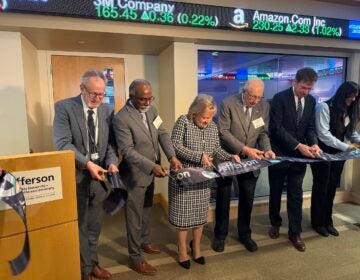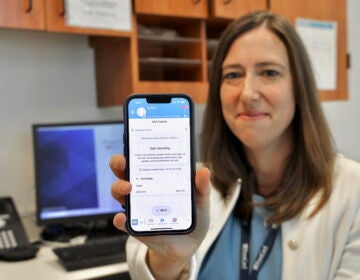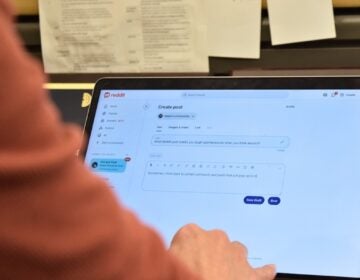Why trade jobs like plumbing are safe from A.I. — for now
At the dawn of what some are calling a fourth industrial revolution powered by artificial intelligence, what are the limitations when it comes to fixing a pipe?
Listen 9:53
A plumber installs a kitchen faucet on a home under construction in Sacramento, Calif. (AP Photo/Rich Pedroncelli)
This story is from The Pulse, a weekly health and science podcast.
Find it on Apple Podcasts, Spotify, or wherever you get your podcasts.
In 1981, Roger Wakefield was managing a hamburger restaurant when his best friend asked him a lifechanging question.
“He said, ‘Are you going to do this forever?” said Wakefield.
At the time, Wakefield was 16 years old and he e had always liked working with his hands rather than with other people. But on that slow Tuesday night in Texas, he told his friend the gig seemed too good to ever let go.
“And he looks at me and says, ‘So what happens if you quit or you get fired? Who’s going to hire you?’ And I never thought about that,” Wakefield said. “It was the 1980s. We were talking robots are going to take over. They’re going to do all the manufacturing jobs, they are going to do all the industrial jobs.”
It was only a matter of time before their jobs became redundant or irrelevant, his friend said.
They were left with a choice between two futures: one for those who built and owned the robots and one for those who would be replaced by them.
Wakefield never took to school, so his fate seemed aligned with the latter. But then his friend told him about a third path his father and brothers chose: to become a plumber.
He said, “‘Roger, look, robots will never be able to do plumbing,’” Wakefield said.
So far, his friend has been right.
Wakefield has been a master plumber for over 40 years, and while fast food chains continue to turn to technology, Wakefield has yet to see a robot even attempt what he and his fellow tradesmen can do.
But now at the dawn of what some are calling a fourth industrial revolution powered by artificial intelligence, how long will this remain true?
Subscribe to The Pulse
Take Atlas, for example – a large humanoid robot made by Boston Dynamics. It looks a bit like a life-size transformer toy whose dormant disguise might be a mini-fridge.
In a promotional video released this year, the robot walks on two legs and skillfully navigates a worksite, using large pincher-like hands to pick up and throw a large bag of tools through scaffolding. It even executes a perfect somersault.
Atlas seems like a fantastic assistant (aside from the numerous alleged OSHA violations depicted in the video).
The obvious question lingers: If machines can now move like an athlete and communicate like a lover, what’s stopping them from fixing a pipe like Roger Wakefield?
According to Nikhil Krishnaswamy, assistant professor of computer science at Colorado State University, a lot.
“I feel like people are not necessarily well informed about … what A.I. actually is and what it does and does not do,” Krishnaswamy said.
If a robot plumber – like one that might show up at “The Jetsons’” front door – was on the horizon, Krishnaswamy would know about it. His primary area of research includes artificial intelligence and natural language processing with “embodied agents” that use language to interact with people.
But Krishnaswamy said this kind of technology remains far off in the future for several reasons.
First and foremost because while there has been a lot of development in the fields of artificial intelligence and robotics since the 1980s, even the most advanced models that control these robots and complex programs have something like a one-track mind.
“The models as they exist right now are task-based. That is, I build a model to do something [very specific].” Krishnaswamy said.
A robot like Boston Dynamic’s Atlas may seem like it can make its way through all arenas – ready to jump in and help a human out with any task its asked to complete. But Krishnaswamy said this is an illusion.
“In those cases, the environment is known beforehand and it’s controlled,” he said.
While it may look like Atlas navigates scaffolding better than a real person, the robot really moves through the environment like a train on invisible tracks. Its actions are carefully plotted out before the camera rolls.
Krishnaswamy said this is the reason most autonomous robots used on real job sites today operate in controlled spaces that are predictable and mappable — like warehouses.
“Once you have the schematics of the warehouse and you know where all the items are located, then you’ve reduced the problem space down to maybe things like obstacle avoidance and things like that. And so that makes it much less hairy,” Krishnaswamy said.
Imagine all of the different settings a plumber encounters, from a cramped city rowhome with old rusty pipe to a sleek, modern condo with brand new fixtures and appliances.
“It’s not quite sophisticated enough to really cope with these continuous and dynamic environments.” said Krishnaswamy. “And then also there’s a question about like, can we use ‘large language models’ to assist with this?”
This, too, remains an open question.
Large language models like ChatGPT use advanced statistics to predict how a word should follow a sequence of other words to create convincing responses to certain prompts. ChatGPT can already provide a fairly competent guide to fix a pipe and write simple code lightning fast to help build computer applications.
Could these abilities allow a competent autonomous robot in the future to fix that pipe for you? To quickly generate its own bespoke instructions to complete tasks it wasn’t necessarily optimized for?
Maybe, Krishnawamy said, but not before many other complex issues are solved.
“There’s still a whole ton of infrastructure that has to be built up to execute each of the subtasks that the large language model might come up with as part of its plan. And then it still can only be done in domains and environments that are friendly to tasks that have those particular subtasks in them.” Krishnaswamy said.
Large language models use math to convincingly structure a document or sort through a spreadsheets. These tasks don’t require the machine completing them to have spatial reasoning, a sense of space that is inherent to humans — and most trade jobs like plumbing.
“[Trade jobs] really involve reasoning about space and the body in the world that most of the current A.I. technologies really are not equipped to do that well,” said Krishnaswamy. “So spatial reasoning is really one of these capabilities that is very well grounded in people. And interestingly, there is evidence that it’s not completely innate and that it is something that’s learned from experience. So for example, there’s a critical period in the development of young children where their sense of space really develops and often young children kind of go through this phase where they’re like afraid of things like the drain in the bathtub because they don’t perceive the fact that it’s much smaller than them and it can’t actually suck them down.”
This is a fear humans naturally grow out of. Eventually people gain a feel for where things are in space and how it relates to themselves and what’s around them — like intuitively understanding that when two people face each other an object may be on one person’s left and on the other person’s right.
Even though this is a fundamental part of our cognition – it’s hard to mimick this behavior in machines.
“Computers require very precise numerical values to do the reasoning humans don’t.” said Krishnaswamy. “So when we’re talking about, let’s say someone trying to fix a pipe there are some rules that you could follow that like a language model might be able to learn like, say, turn right to tighten and turn left loosen.
“But that’s all going to be conditioned on where you are positioned relative to the object. So for example, I’m trying to plug two pipes together but I have to orient myself in a tricky way, I might actually have to turn the one pipe in a way that is perceived to be left. But that’s left-oriented to make, but clockwise, counterclockwise oriented to the two pipes.”
One way around this problem might be to optimize our real-world architecture for automated upkeep so that robots have a reliable map to situate themselves within.
But this would be very expensive and time-consuming.
“In principle, if we were to tear down all our buildings and build them up according to the schematic that the A.I. can navigate, yeah, we probably could have spatial reasoning robots that are fixing our plumbing in office buildings as soon as that was finished,” said Krishnaswamy. “But imagine, of course, what it actually takes to rebuild entire society based on some sort of schematic that is A.I. friendly.”
Another big problem is data. Once a robot is built that can reliably navigate a home and prop itself under a leaky sink, how would it know what to do with all the information it gathers from its various sensors?
It would have to be trained in all sorts of different scenarios specific to plumbing. So where would this information come from? Would plumbers have to wear go-pros and send all the videos they capture on the job back to more plumbers to label what kind of data they see?
“I can see that being kind of a plausible way to getting something sort of like a video version of ChatGPT for plumbers. I could see that data being very useful,” said Krishnaswamy.
“But again, I think we might still run into the problem of once you get into a situation that is sufficiently outside the training data, which could just be, ‘I’m looking at something from a strange angle.’ Suddenly, it’s going to suggest something that is incorrect or not be able to process the scene. And I think we also might consider the price of the GoPros, paying the presumably trained plumbers to label this data, to say nothing of how much processing power would take to process the video and then generate the output. Wouldn’t it just be easier to just pay an actual plumber?”
This is why Roger Wakefield still feels his job is still safe from robots – even after four decades.
Plumbing is too complicated for a robot to replace. Too human.
“I think it’ll be a long time before a robot can go out into the field, dig a ditch, carry the pipe over, put it together, join it properly, turn the fittings the right way,” said Wakefield. “And am I going to say it’s never going to happen? Absolutely not. Am I going to say it’s going to happen anytime soon? I haven’t seen that robot yet.”
That’s not to say technology hasn’t changed the industry over the years – and won’t continue to.
While the number of businesses providing plumbing services continues to grow, so does consolidation within the industry.
Big companies are buying out smaller companies and finding profit in scale.
“The company that bought me out is now looking at buying out other companies,” said Wakefield, who happily sold his own plumbing business over a year and a half ago. “The bigger your revenue gets the more your multiplier becomes. They learn to train their people in sales. They brand better than anybody. They have the best uniforms, the best-looking trucks, the best marketing, the best television, the best radio, the best of everything. And they are not the cheapest company in town. They are the most expensive.”
While these companies won’t roll out autonomous robot plumbers anytime soon, they are using technology in ways Wakefield could never have imagined back when he first got into the business.
“Most of these big plumbing companies, these guys are carrying ipads, they’re computers, they’re doing their invoicing, they’re estimating their billing.” said Wakefield. “Everything is done through a computer. If you’d have told me 10 years ago, the computer will be the most important tool you’d have with you every day, I’d have thought you were crazy.”
WHYY is your source for fact-based, in-depth journalism and information. As a nonprofit organization, we rely on financial support from readers like you. Please give today.







